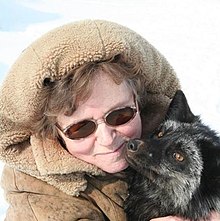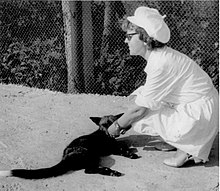Lyudmila Trut
Lyudmila Trut | |
|---|---|
Людмила Трут | |
 Trut in 2012 | |
| Born | Lyudmila Nikolayevna Trut 6 November 1933 |
| Died | 9 October 2024 (aged 90) Novosibirsk, Russia |
| Awards |
|
Lyudmila Nikolayevna Trut (Russian: Людми́ла Никола́евна Трут; 6 November 1933 – 9 October 2024) was a Russian geneticist, ethologist, and evolutionist. She is known for developing domesticated silver foxes from wild foxes with Dmitry Belyayev at the Institute of Cytology and Genetics in Novosibirsk, Russia. The experiment, started in 1952, continues to this day covering nearly 60 generations of silver foxes selected for "tameness."[1] She held the positions of Senior researcher for Evolutionary genetics, Institute of Cytology and Genetics SB AS USSR, from 1969 to 1985; Head of Laboratory for Evolutionary Genetics, Institute of Cytology and Genetics, USSR, 1985 to 1990; Main Scientific Employee in the Laboratory for Evolutionary Genetics, Institute of Cytology and Genetics SB AS USSR, from 1990; and Professor in Genetics, from 2003 at the Institute of Cytology and Genetics.[2][3] She coordinated educational activities at the experimental fox farm at the Institute of Cytology and Genetics of the Russian Academy of Sciences in Novosibirsk, Russia. Trut was elected to the American Academy of Arts and Sciences in 2020.[4] She died in Novosibirsk on 9 October 2024, at the age of 90.[5]
Early life and education
[edit]Trut grew up in the town of Kirzhach in the Soviet Union, now Russia. She graduated with Honors at Moscow State University in 1958, majoring in biology. In 1966, she earned a Candidate of Sciences degree from the Institute of Cytology and Genetics in Novosibirsk. Her thesis was titled: "On correlation of behavior characteristics with reproductive function in fur bearing animals of the Canidae family." In 1981, she was awarded a Doctor of Sciences degree from the same institution, writing her thesis on the behavior of domesticated silver foxes.
Research
[edit]
The silver fox is a melanistic form of the red fox. Domesticated silver foxes are the result of an experiment which was designed to demonstrate the power of selective breeding to transform species, as described by Charles Darwin in On the Origin of Species.[6] The experiment explored whether selection for tame behavior produced dogs from wolves. Only the tamest members of each generation were allowed to breed, and the changes in the population were recorded. Many of the descendant foxes became both tamer and more dog-like in morphology, including displaying mottled or spotted fur.[7][8]
The experiment was under the supervision of Trut.[9][10][8]
References
[edit]- ^ Trut, Lyudmila; Dugatkin, Lee Alan (2017). "How to Build a Dog". Scientific American. 316 (5): 68–73. Bibcode:2017SciAm.316e..68T. doi:10.1038/scientificamerican0517-68. PMID 28437410.
- ^ Browne, Malcolm (30 March 1999). "New Breed of Fox as Tame as a Pussycat". New York Times.
- ^ Dugatkin, L.A.; Trut, L.N. (2017). How to Tame a Fox (and Build a Dog): Visionary Scientists and a Siberian Tale of Jump-Started Evolution. Chicago: University of Chicago Press. p. 240.
- ^ "New Members". American Academy of Arts & Sciences. Retrieved 23 April 2020.
- ^ Умерла Людмила Трут — доктор биологических наук из Новосибирска (in Russian)
- ^ Darwin, Charles (1859). "1". On the Origin of Species by Means of Natural Selection, or the Preservation of Favoured Races in the Struggle for Life (1963 reprint ed.). Norwalk, Connecticut: Heritage Press. p. 470.
- ^ Trut, Lyudmila (1999). "Early Canid Domestication: The Farm-Fox Experiment". American Scientist. 87 (2): 160. Bibcode:1999AmSci..87.....T. doi:10.1511/1999.2.160. JSTOR 27857815.
- ^ a b Trut, Lyudmilla; Dugatkin, Lee Alan (23 March 2017). How to Tame a Fox (and Build a Dog): Visionary Scientists and a Siberian Tale of Jump-Started Evolution (1st ed.). Chicago: University Of Chicago Press. p. 240. ISBN 978-0226444185.
- ^ "Domestication of foxes and problems of modern animal breeding". www.bionet.nsc.ru. Retrieved 5 July 2016.
- ^ "Why domesticated foxes are genetically fascinating (and terrible pets)". pbs.org. 31 March 2017.
- 1933 births
- 2024 deaths
- Russian geneticists
- Women geneticists
- Ethologists
- Scientists from Novosibirsk
- 20th-century Russian zoologists
- 20th-century Russian women scientists
- 21st-century Russian zoologists
- 21st-century Russian women scientists
- Women zoologists
- Recipients of the Order of the Badge of Honour
- Fellows of the American Academy of Arts and Sciences
